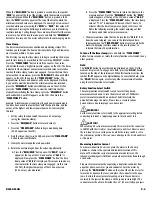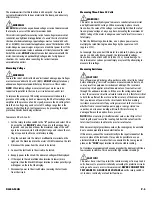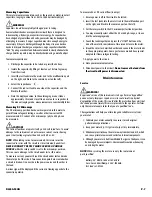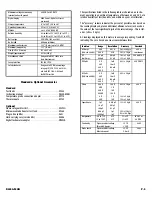
DL250-MAN
P. 5
Measuring Three-Phase AC Volts
WARNING!
This meter is primarily designed to measure residential, commercial
and light industrial AC voltage. When measuring 3-phase circuits,
line-to-line, the value of the voltage is actually higher than the rated
line-to-ground voltage at any one phase. Exceeding the maximum AC
(RMS) rating of this meter is dangerous and could result in serious or
fatal injury.
To find the RMS voltage, line-to-line, on a 3-phase power source,
multiply the rated line-to-ground voltage by the square root of 3
(approx. 1.732).
For example, if you connect this meter to a 480 volt, 3-phase, power
source (i.e. 480 volts line-to-ground), the total available voltage,
line-to-line, is about 832 volts AC (480 x 1.732). Severe damage to
the instrument or serious personal injury may result by attempting to
measure this voltage.
Measuring Resistance
CAUTION!
Turn off power and discharge all capacitors on the circuit to be tested
before attempting “in circuit” resistance measurements. Failure to do
so may result in equipment or instrument damage. The resistance
measuring circuit applies a small, known value of constant current
through the unknown resistance. It then uses the voltage developed
across the measured circuit to calculate resistance. It is therefore critical
to both the welfare of the meter, and the accuracy of the measurement
that you remove all power to the circuit under test when making
resistance measurements. If any voltage is present in the test circuit,
whether from a conventional power supply, or energy stored in a
capacitor, an erroneous reading will result. This meter may be
damaged if more than 600 volts are present.
NOTE:
When measuring critically low ohm values, touch tips of test
leads together and record the reading. Subtract this value from the
total circuit resistance to obtain the most accurate value.
When measuring large resistance values, the reading may be unstable
due to environmentally induced electrical noise.
If this occurs, connect the resistor directly to the input terminals of the
meter in place of the test leads. If may also be possible to use an
electrical shield on the resistor that is connected to the same ground
plane as the “
COM
” input terminal to obtain a stable reading.
For resistance measurements above one megohm the display might take a
f ew seconds to stabilize. This is normal for high resistance readings.
CAUTION!
This meter has a circuit to protect the resistance ranges from up to 600
volts. however, to prevent accidentally exceeding the protection circuits
rating and to ensure a correct measurement,
NEVER CONNECT THE
TEST LEADS TO A SOURCE OF VOLTAGE
when the rotary switch is
set to ohms, continuity or diode test functions.
The maximum limit for this function is 400 amps AC. Too much
current will saturate the ferrous material in the clamp, and adversely
affect accuracy.
WARNING!
DO NOT
attempt to take any unknown voltage or current measure m e n t s
that may be in excess of this meter’s maximum limits.
This meter is designed for measuring current and voltage in commerc i a l ,
residential, and light industrial applications. To avoid the risk of electrical
shock and instrument damage, input voltages must not exceed 600 volts
DC or AC (RMS). Some industrial applications exceed the limitations of this
m e t e r. Dange rous power surges may occur on industrial power lines. If the
maximum measurement value is unknown or is likely to exceed the ra t e d
limit of this meter,
DO NOT
attempt to make that measurement with this
m e t e r. Consider using an optional high voltage probe for high power
situations. Use caution when connecting the current clamp on
uninsulated conductors.
Measuring Voltage
WARNING!
To avoid the risk of electrical shock and instrument damage, input voltage s
must not exceed 600 volts DC or AC (RMS).
DO NOT
attempt to take any
unknown voltage measurements that may be in excess of these values.
NOTE:
When taking voltage measurements your meter must be
connected in parallel to the circuit, or circuit element, under test.
To improve the accuracy of DC voltage measurements taken in the
presence of AC voltages, (such as measuring the DC offset voltage of an
amplifier in the presence of an AC signal), measure the AC voltage first.
Note the AC voltage range and select a DC voltage range that is the
same or higher than the AC voltage accuracy be preventing the input
protection circuits from being activated.
To measure DC or AC volts:
1. Set the rotary function switch to the “
V
” position, and select DC or
AC using the red “
MODE
” button. If you are in the manual rang-
ing mode, and you do not know the maximum value of the volt-
age to be measured, start at the highest range and reduce the set-
ting as required to obtain a satisfactory reading.
2. Plug the red lead into the meter’s multifunction terminal on the
right, and the black lead into the meter’s COM terminal on the left.
3. Disconnect the power from the circuit to be tested.
4. Connect the test leads to the circuit to be tested.
5. Reapply power to the circuit. The measured voltage will be displayed.
6. If the input to the red multifunction terminal is lower (more
negative) than the black COM input terminal, a minus polarity sign
will appear on the left of the display.
7. Disconnect power to the circuit before removing the test leads
from the circuit.











